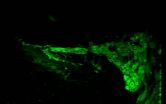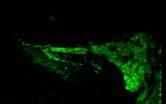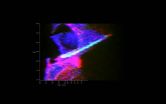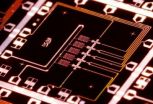(Press-News.org) VIDEO:
This shows regenerated auditory nerves, after gene therapy.
Click here for more information.
Researchers at UNSW Australia have for the first time used electrical pulses delivered from a cochlear implant to deliver gene therapy, thereby successfully regrowing auditory nerves.
The research also heralds a possible new way of treating a range of neurological disorders, including Parkinson's disease, and psychiatric conditions such as depression through this novel way of delivering gene therapy.
The research is published today (Thursday 24 April) in the prestigious journal Science Translational Medicine.
"People with cochlear implants do well with understanding speech, but their perception of pitch can be poor, so they often miss out on the joy of music," says UNSW Professor Gary Housley, who is the senior author of the research paper.
"Ultimately, we hope that after further research, people who depend on cochlear implant devices will be able to enjoy a broader dynamic and tonal range of sound, which is particularly important for our sense of the auditory world around us and for music appreciation," says Professor Housley, who is also the Director of the Translational Neuroscience Facility at UNSW Medicine.
The research, which has the support of Cochlear Limited through an Australian Research Council Linkage Project grant, has been five years in development.
VIDEO:
This is the cochlea four days after gene delivery.
Click here for more information.
The work centres on regenerating surviving nerves after age-related or environmental hearing loss, using existing cochlear technology. The cochlear implants are "surprisingly efficient" at localised gene therapy in the animal model, when a few electric pulses are administered during the implant procedure.
"This research breakthrough is important because while we have had very good outcomes with our cochlear implants so far, if we can get the nerves to grow close to the electrodes and improve the connections between them, then we'll be able to have even better outcomes in the future," says Jim Patrick, Chief Scientist and Senior Vice-President, Cochlear Limited.
It has long been established that the auditory nerve endings regenerate if neurotrophins – a naturally occurring family of proteins crucial for the development, function and survival of neurons – are delivered to the auditory portion of the inner ear, the cochlea.
But until now, research has stalled because safe, localised delivery of the neurotrophins can't be achieved using drug delivery, nor by viral-based gene therapy.
Professor Housley and his team at UNSW developed a way of using electrical pulses delivered from the cochlear implant to deliver the DNA to the cells close to the array of implanted electrodes. These cells then produce neurotrophins.
"No-one had tried to use the cochlear implant itself for gene therapy," says Professor Housley. "With our technique, the cochlear implant can be very effective for this."
While the neurotrophin production dropped away after a couple of months, Professor Housley says ultimately the changes in the hearing nerve may be maintained by the ongoing neural activity generated by the cochlear implant.
"We think it's possible that in the future this gene delivery would only add a few minutes to the implant procedure," says the paper's first author, Jeremy Pinyon, whose PhD is based on this work. "The surgeon who installs the device would inject the DNA solution into the cochlea and then fire electrical impulses to trigger the DNA transfer once the implant is inserted."
Integration of this technology into other 'bionic' devices such as electrode arrays used in deep brain stimulation (for the treatment of Parkinson's disease and depression, for example) could also afford opportunities for safe, directed gene therapy of complex neurological disorders.
"Our work has implications far beyond hearing disorders," says co-author Associate Professor Matthias Klugmann, from the UNSW Translational Neuroscience Facility research team. "Gene therapy has been suggested as a treatment concept even for devastating neurological conditions and our technology provides a novel platform for safe and efficient gene transfer into tissues as delicate as the brain."
INFORMATION: END
Hearing quality restored with bionic ear technology used for gene therapy
Existing cochlear technology used in a new way to re-grow auditory nerves
2014-04-23
ELSE PRESS RELEASES FROM THIS DATE:
Study shows aspirin can reduce colorectal cancer risks for those with specific gene
2014-04-23
The humble aspirin may have just added another beneficial effect beyond its ability to ameliorate headaches and reduce the risk of heart attacks: lowering colon cancer risk among people with high levels of a specific type of gene.
The extraordinary finding comes from a multi-institutional team that analyzed data and other material from two long-term studies involving nearly 128,000 participants. The researchers found that individuals whose colons have high levels of a specific gene product — 15-hydroxyprostaglandin dehydrogenase (15-PGDH) RNA — dramatically reduce their ...
Atomic switcheroo explains origins of thin-film solar cell mystery
2014-04-23
OAK RIDGE, Tenn., April 23, 2014 — Treating cadmium-telluride (CdTe) solar cell materials with cadmium-chloride improves their efficiency, but researchers have not fully understood why. Now, an atomic-scale examination of the thin-film solar cells led by the Department of Energy's Oak Ridge National Laboratory has answered this decades-long debate about the materials' photovoltaic efficiency increase after treatment.
A research team from ORNL, the University of Toledo and DOE's National Renewable Energy Laboratory used electron microscopy and computational simulations ...
Economics = MC2 -- A portrait of the modern physics startup
2014-04-23
WASHINGTON D.C., April 23, 2014 -- For much of the 20th century, many of the technological innovations that drove U.S. economic growth emerged from "idea factories" housed within large companies -- research units like Bell Labs or Xerox PARC that developed everything from the transistor to the computer mouse.
In recent decades, however, many large high-tech companies have eliminated in-house research programs, turning instead to startup companies as their primary source of breakthrough innovations.
"Small startups have replaced corporate research centers as the drivers ...
Pollutants from coal-burning stoves strongly associated with miscarriages in Mongolia
2014-04-23
Burning coal for domestic heating may contribute to early fetal death according to a new study by experts from The Saban Research Institute of Children's Hospital Los Angeles and Ulaanbaatar, Mongolia – the coldest capital city in the world.
In a paper published today in the journal BMC Pregnancy and Childbirth, researchers report
"alarmingly strong statistical correlations" between seasonal ambient air pollutants and pregnancy loss in Ulaanbaatar (UB), Mongolia.
UB has one of the highest levels of air pollution of all world capitals, with sulfide dioxide and particulate ...
Superconducting qubit array points the way to quantum computers
2014-04-23
A fully functional quantum computer is one of the holy grails of physics. Unlike conventional computers, the quantum version uses qubits (quantum bits), which make direct use of the multiple states of quantum phenomena. When realized, a quantum computer will be millions of times more powerful at certain computations than today's supercomputers.
A group of UC Santa Barbara physicists has moved one step closer to making a quantum computer a reality by demonstrating a new level of reliability in a five-qubit array. Their findings appear Thursday in the journal Nature.
Quantum ...
Cyber buddy is better than 'no buddy'
2014-04-23
A Michigan State University researcher is looking to give exercise enthusiasts the extra nudge they need during a workout, and her latest research shows that a cyber buddy can help.
The study, which appears in the Games for Health Journal, is the first to indicate that although a human partner is still a better motivator during exercise, a software-generated partner also can be effective.
"We wanted to demonstrate that something that isn't real can still motivate people to give greater effort while exercising than if they had to do it by themselves," said Deborah Feltz, ...
Male or female?
2014-04-23
This news release is available in French and German. Man or woman? Male or female? In humans and other mammals, the difference between sexes depends on one single element of the genome: the Y chromosome. It is present only in males, where the two sexual chromosomes are X and Y, whereas women have two X chromosomes. Thus, the Y is ultimately responsible for all the morphological and physiological differences between males and females.
But this has not always been the case. A very long time ago, the X and Y were identical, until the Y started to differentiate from the ...
Hundreds of genetic mutations found in healthy blood of a supercentenarian
2014-04-23
April 23, 2014 – Genetic mutations are commonly studied because of links to diseases such as cancer; however, little is known about mutations occurring in healthy individuals. In a study published online in Genome Research, researchers detected over 400 mutations in healthy blood cells of a 115-year-old woman, suggesting that lesions at these sites are largely harmless over the course of a lifetime.
Our blood is continually replenished by hematopoietic stem cells that reside in the bone marrow and divide to generate different types of blood cells, including white blood ...
From liability to viability: Genes on the Y chromosome prove essential for male survival
2014-04-23
CAMBRIDGE, Mass. (April 23, 2014) – Despite a well-documented history of dramatic genetic decay, the human Y chromosome has over the course of millions of years of evolution managed to preserve a small set of genes that has ensured not only its own survival but also the survival of men. Moreover, the vast majority of these tenacious genes appear to have little if any role in sex determination or sperm production.
Taken together, these remarkable findings—published this week in the journal Nature—suggest that because these Y-linked genes are active across the body, they ...
New target for prostate cancer resistant to anti-hormone therapies
2014-04-23
ANN ARBOR, Mich. — Prostate cancer becomes deadly when anti-hormone treatments stop working. Now a new study suggests a way to block the hormones at their entrance.
Researchers from the University of Michigan Comprehensive Cancer Center have found that a protein called BET bromodomain protein 4 binds to the hormone androgen receptor downstream of where current therapies work – targeting androgen receptor signaling.
This could mean that when prostate cancer becomes resistant to current treatments, it might remain sensitive to a drug that targets BET bromodomain proteins. ...
LAST 30 PRESS RELEASES:
Revealing the diversity of olfactory receptors in hagfish and its implications for early vertebrate evolution
Development of an ultrasonic sensor capable of cuffless, non-invasive blood pressure measurement
Longer treatment with medications for opioid use disorder is associated with greater probability of survival
Strategy over morality can help conservation campaigns reduce ivory demand, research shows
Rising temperatures reshape microbial carbon cycling during animal carcass decomposition in water
Achieving ultra-low-power explosive jumps via locust bio-hybrid muscle actuators
Plant-derived phenolic acids revive the power of tetracycline against drug-resistant bacteria
Cooperation: A costly affair in bacterial social behaviour?
Viruses in wastewater: Silent drivers of pollution removal and antibiotic resistance
Sub-iethal water disinfection may accelerate the spread of antibiotic resistance
Three in four new Australian moms struggle with body image
Post-stroke injection protects the brain in preclinical study
Cardiovascular risk score predicts multiple eye diseases
Health: estimated one in ten British adults used or interested in GLP-1 medications for weight loss
Exercise to treat depression yields similar results to therapy
Whooping cough vaccination for pregnant women strengthens babies’ immune system
Dramatic decline in new cases of orphanhood in Uganda driven by HIV treatment and prevention programs
Stopping weight loss drugs linked to weight regain and reversal of heart health markers
Higher intake of food preservatives linked to increased cancer risk
Mass General Brigham–developed cholera vaccine completes phase 1 trial
First experimental validation of a “150-year-old chemical common sense” direct visualization of the molecular structural changes in the ultrafast anthracene [4+4] photocycloaddition reaction
Lack of support for people on weight loss drugs leaves them vulnerable to nutritional deficiencies, say experts
Dogs’ dinners can have greater climate impact than owners’
Are you ready to swap salmon for sprats and sardines?
1.6 million UK adults used weight loss drugs in past year
American College of Cardiology comments on new dietary guidelines for Americans
American Society of Gene & Cell Therapy and Orphan Therapeutics Accelerator partner to advance and commercialize promising rare disease treatments
One in 14 patients having day case surgery have new or worse chronic pain 3 months after their operation
New study highlights link between eviction rates and gun violence
Heatwaves heat up soil but not toxin levels in rice, study finds
[Press-News.org] Hearing quality restored with bionic ear technology used for gene therapyExisting cochlear technology used in a new way to re-grow auditory nerves









